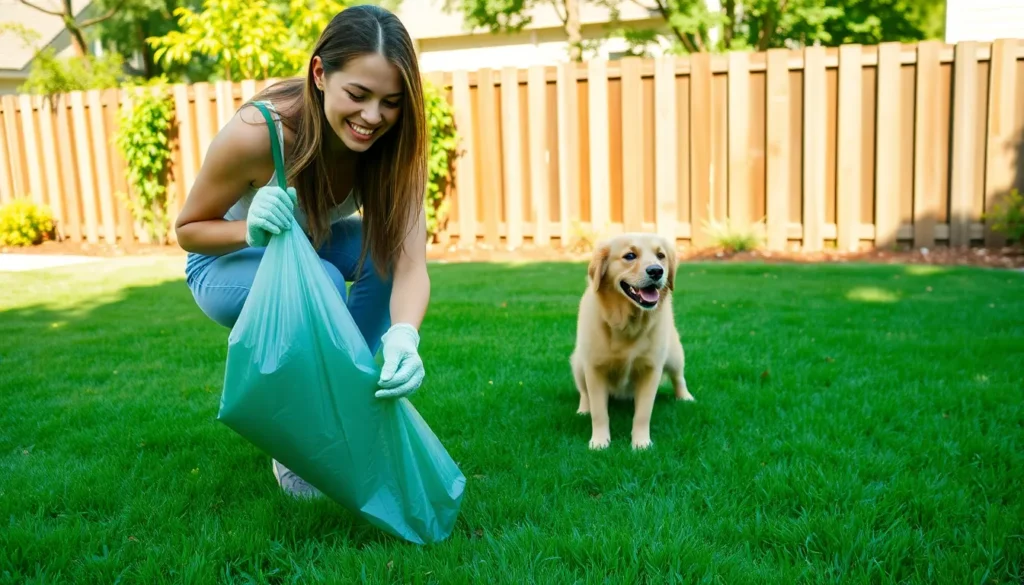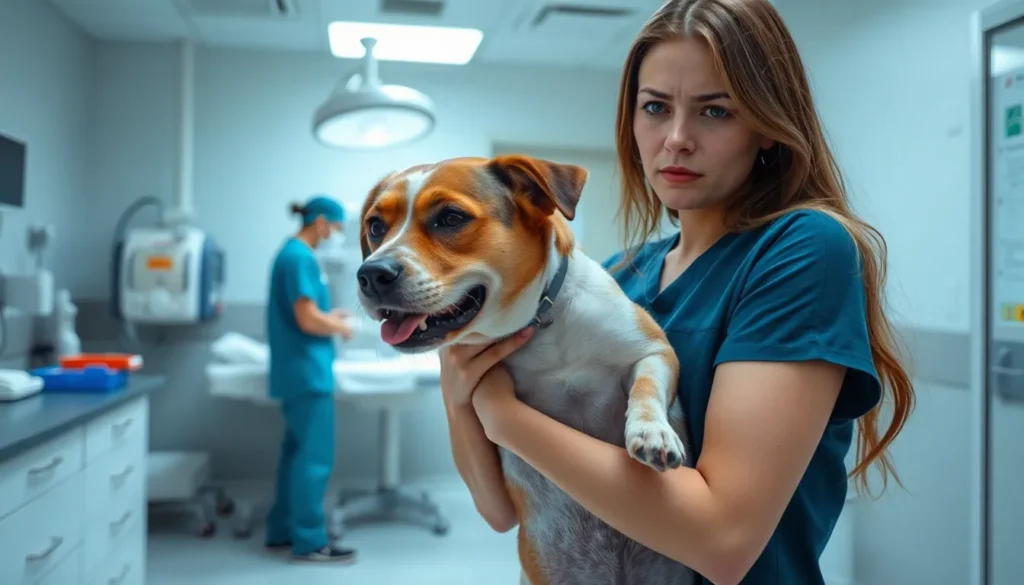Training pets can feel like trying to teach a cat to fetch—frustrating and often hilarious. Enter pet training spray, the unsung hero of the pet training world. This magical concoction can turn your mischievous furball into a well-behaved companion faster than you can say “sit.”
Table of Contents
ToggleOverview of Pet Training Spray
Pet training spray serves as an effective tool for enhancing behavioral training in pets. It aids in redirecting unwanted behavior, ensuring that pets learn more desirable actions.
What Is Pet Training Spray?
Pet training spray is a specialized product designed for correcting behavioral issues in animals. Generally, this spray is composed of non-toxic ingredients that deter pets from undesirable actions. Common formulations include scents that pets find unpleasant, such as citrus or bitter flavors. Many owners use these sprays to prevent pets from chewing furniture, scratching furniture, or marking territory in inappropriate areas.
How Does Pet Training Spray Work?
Pet training spray functions by creating a negative association with specific behaviors. When a pet engages in an undesirable action, the owner applies the spray to the area or object of interest. The unpleasant scent or taste discourages the pet from repeating the behavior. Consistent use reinforces this practice, helping pets understand that certain actions lead to unpleasant experiences. Effective training often requires repetition and gradual reinforcement to achieve lasting results.
Benefits of Using Pet Training Spray

Pet training spray offers significant advantages for pet owners aiming to cultivate desirable behaviors. These sprays often serve as essential tools in behavioral correction and positive reinforcement strategies.
Behavioral Correction
Behavioral correction becomes easier with pet training spray. This tool creates negative associations with unwanted behaviors, such as scratching furniture or excessive barking. When pets encounter the unpleasant scent or taste, they learn to associate it with their undesirable actions. Consistency is key; repeated application enables pets to grasp which behaviors are inappropriate. As a result, pet training spray fosters a more disciplined environment for both pets and owners.
Positive Reinforcement
Positive reinforcement benefits from the use of pet training spray as well. When a pet avoids undesirable behaviors, owners can reinforce good conduct with treats or praise. This combination strengthens the learning process; as pets receive rewards for positive actions, they’re motivated to repeat those behaviors. Furthermore, the training spray acts as a consistent reminder of the boundaries, enhancing overall effectiveness. Through this method, pets develop a clear understanding of acceptable actions, leading to lasting behavioral improvement.
Types of Pet Training Spray
Various types of pet training sprays exist, each targeting specific behaviors to help owners train their pets effectively.
Scent-Based Sprays
Scent-based sprays utilize unpleasant odors to deter pets from unwanted behaviors. Formulated with strong scents, these sprays create negative associations. For instance, a common ingredient like citrus or vinegar can discourage pets from chewing furniture or other items. When sprayed in areas where pets tend to misbehave, they quickly learn to avoid those spaces. Consistent application reinforces their understanding, leading to a more disciplined demeanor. Many pet owners appreciate the non-toxic nature of these sprays, ensuring safety while effectively managing behaviors.
Noise-Based Sprays
Noise-based sprays emit sounds to interrupt unwanted actions. These sprays often release a burst of noise when triggered, startling pets and redirecting their attention. When pets engage in undesirable behavior like barking or scratching, the noise serves as an effective deterrent. Each activation helps create a connection between the unwanted action and the startling sound. Over time, pets learn to associate the noise with their behavior, which helps them modify their actions. Many find noise-based sprays particularly useful in training dogs, as they respond well to auditory cues.
How to Choose the Right Pet Training Spray
Selecting the appropriate pet training spray requires careful consideration of various factors. Knowing what ingredients to prioritize and what specifics to keep in mind helps ensure effectiveness while safeguarding pet health.
Ingredients to Look For
Focus on non-toxic components like natural essential oils and plant-based ingredients. Citrus oil serves as a popular deterrent due to its strong scent, effective against many pets. Vinegar also offers a safe option, providing a bitter taste that many animals avoid. Ensure the spray is free of harmful chemicals or synthetic additives, which can pose risks to pets’ health. Look for products that specify their ingredient sourcing, demonstrating a commitment to safety and quality. Transparency helps in making informed decisions about what’s safe for pets.
Factors to Consider
Evaluate the type of behavior targeted by the spray. Some sprays specifically address chewing or marking behaviors, while others may help with training specific commands. Assess the formulation and the method of application for ease of use. Spray bottles with adjustable nozzles facilitate accurate application in various situations. Consider the training environment; indoor sprays might differ in effectiveness compared to outdoor options. Lastly, examine user reviews and testimonials to gauge real-life success rates, contributing to a well-rounded understanding of each product’s performance.
Tips for Effective Use of Pet Training Spray
Utilizing pet training spray effectively requires attention to application techniques and safety considerations. Implementing the right methods enhances training outcomes while keeping pets protected.
Proper Application Techniques
Begin by identifying the specific behavior to address. Use the spray directly on the area or object associated with the undesired action. Maintain a consistent distance when applying the spray, ensuring that the intended area receives sufficient coverage without overwhelming the pet. During training sessions, apply the spray immediately after the unwanted behavior occurs to establish a clear connection. Encourage the pet to explore alternative options and reward them once they avoid the denied behavior, reinforcing positive outcomes over time. Regularly assess the effectiveness of the spray and adjust the application frequency as necessary to optimize results.
Safety Precautions
Safety remains paramount during the use of pet training spray. Always choose non-toxic options that contain safe ingredients, avoiding harmful chemicals. Conduct a patch test on surfaces to ensure no staining or damage occurs. Keep the spray out of pets’ reach to prevent accidental ingestion. Should a pet exhibit adverse reactions, discontinue use and consult a veterinarian immediately. Consider the environment when applying the spray, ensuring proper ventilation to minimize inhalation of accidental mist. Additionally, store the spray in a cool, dry place to maintain its efficacy and safety.
Pet training spray serves as an invaluable resource for pet owners striving to correct unwanted behaviors. Its ability to create negative associations helps pets understand which actions are inappropriate while reinforcing desirable conduct through positive reinforcement. By choosing the right formulation and applying it consistently, owners can foster a disciplined environment that promotes lasting behavioral change.
With various options available tailored to specific behaviors, selecting the right spray can make all the difference in the training process. Prioritizing safety and effectiveness ensures that pets not only learn but thrive in a well-structured setting. Embracing pet training spray can lead to a more harmonious relationship between pets and their owners, paving the way for a well-behaved companion.








